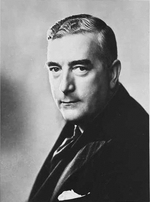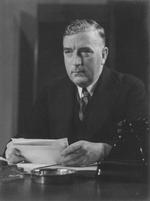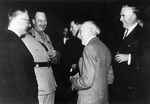Robert Menzies
| Surname | Menzies |
| Given Name | Robert |
| Born | 20 Dec 1894 |
| Died | 15 May 1978 |
| Country | Australia |
| Category | Government |
| Gender | Male |
Contributor: Morgan Bell
ww2dbaseRobert Gordon Menzies, like John Curtin, was born near the end of the nineteenth century in rural Victoria, at a time when Japan was at the beginning of its territorial expansion through war, with the Sino-Japanese War of 1894-95. Unlike Curtin, Menzies came from a middle class family, taking advantage of the wealth and opportunity afforded by his status and background, received a good education and won scholarships to the reputable Wesley College, then went on to study law at Melbourne University in 1922, taking bar examinations, and becoming a lawyer, becoming a known figure in the Melbourne legal world, even appearing in constitutional cases before the High Court, and industrial cases in the Arbitration Court. His success prompted him to consider politics. Knowing on which side his bread was buttered on, he flew the flag for the conservative side of politics. He was elected to the Victorian parliament in 1928. Rallying the anti-labour members of the Victorian parliament under the banner of a conservative party, the United Australia Party, the UAP, Menzies came to the notice of the federal UAP leadership in Canberra. Securing the federal seat of Kooyong for the UAP in 1934, Menzies came into the ministry of the Lyons government as attourney-general. Throughout their political career both Menzies and Curtin argued that Australia should respond to the Japanese expansion in different ways that they believed was beneficial to the country. Whereas Curtin and his Labor ministers argued for local defence to oppose any threat Japan might pose, a threat suspected since the Russo-Japanese War of 1904-05, Menzies as part of the conservative UAP party believed that Britain would hold its side of the policy of imperial defence, and Japanese territorial expansion brought opportunity for trade as well as threat. While Curtin became involved in the labour movement through an attraction to socialism to address the issues of poverty in modern society, Menzies ruthlessly opposed the Communist Party of Australia, as well as international socialism wherever it was found. When the Communist Party of Australia, the CPA, strengthened links with the Chinese Communist Party, the CCP, meeting for the Pan-Pacific Conference in Hankow in 1927 to discuss Japanese imperialism, Menzies was attourney-general in the Bruce-Page government. The CPA members returned to Australia enthused to begin a campaign against economic links with Japan, boycotting the Japanese manufactured goods, and opposing the sale of primary produce and goods to her. It was at this inopportune time that BHP Company acquired a contract from Mitsui Corporation for 23,000 tons of pig iron. The Waterside Worker's Union, which had Tom Roach and Jim Healey, both CPA members, on its executive board, refused to load the pig iron onto the Dalfram at Port Kembla, arguing that it was most likely to be used in the manufacture of munitions to kill Chinese, and if Japan expands southward, could be used as effectively to kill Australians. The CPA members quoted Article 16 of the League of Nations charter as justification for the stoppage. Menzies confronted the strikers, saying that he did not wish to see the union “substituting its will for the policy of the government”, then added "We ought not to be the one country in the world to impose sanctions against Japan", the workers then offering to load wool and wheat, raw products that had less lethal end purposes, to which Menzies argued naively, "I have no doubt that a very large amount of steel is used in Japan for civil purposes. I do not see any distinction between pig iron and wheat." This was the first Mitsui contract BHP got for some time, so the government was anxious to make a good impression. Menzies forced the workers to load all 23,000 tons of pig iron, earning him the name in labour circles "pig-iron Bob", Later it was discovered that Japan was trading with Germany via the Soviet rail system, and with Britain declaring war on Germany, Mitsui was blacklisted as trading with the enemy. Thus was exposed a conflict in Menzies' politics at the start of the Second World War: Japanese trade or imperial defence? On 3 September 1939, Menzies was sure where his priorities lay, finally prime minister of a minority government, only six months old, under assault from the Australian Labor Party in parliament over the woeful state of local defence and needing to satisfy the Country Party, who represented the farmers who sold their harvest to Britain, announced to the nation "It is my melancholy duty to officially inform you that as a consequence of persistence by Germany in her invasion of Poland, Great Britain has declared war on her and as a result Australia is at war". Menzies was too legalistic to contemplate a situation where the king was at war in Britain, yet simultaneously at peace in Australia. Despite his allegiance to Britain, Menzies laid the foundation that prepared Australia for war: he raised the 2nd AIF and sent it to the Middle East, where it gained combat experience, and instituted the Empire Air Training Scheme, which gave the RAAF combat experience in the skies over Europe, and multiplied the RAAF's number of air and ground crew eleven times over. In 1941 he climbed aboard a QANTAS Empire Airways flying boat, leaving the leader of the Country Party, Arthur Fadden, as acting prime minister, while Menzies flew across a warring world, bound for London. As motivation for his departure, Menzies hoped to be able to convince Churchill, personally, of the inadequacy of Singapore's defences, and its need of a British fleet. En route, he planned to visit Singapore to witness its deficiencies in providing for Australia's defence firsthand, then on to visit Australian troops in a public relations exercise. Needless to say, Menzies did not extract an useful assurance from Churchill, once in London, Menzies' huge ambition was enticed on by political and military figures, disenchanted with Churchill's dominance of strategy, who were looking for an inspiring figure to rally around. The press repeatedly suggested Menzies, who hoped to meet with other dominion heads and he be a dominion representative to represent all their interests in the British war cabinet. To Menzies' requests to Churchill to house a British fleet at Singapore, Churchill repeatedly gave the assurance that the British would abandon the Mediterranean to send Royal Navy support to Singapore. Menzies was in a bind. Having seen Australian troops in the Middle East recently, he knew they would need reinforcement and supply, so the Australian public would not tolerate an abandoning of the Mediterranean. In an effort to reinforce Singapore while not abandoning the Mediterranean, Menzies suggested Hurricanes be sent to Singapore, to which Churchill agreed, but when they were sent, they were unassembled, not ready for battle, so it was to little, too late. They served the purpose for which Menzies requested them, so he would not have to fly back to Australia empty-handed, however, when he returned to Australia, he was forced to resign, as Arthur Fadden proved to be reasonably popular in Australia's top role, and convinced independent MP's that Menzies relied upon to vote against him. Menzies repeatedly proposed a national government to Labor, to no avail, so Menzies was consigned to the opposition benches, just as Labor took government by mandate, then the UAP decided to replace Menzies as leader with Billy Hughes, the party, however, was in decline, since the Depression that created it was over, Labor won a landslide victory in 1943. In an attempt to delay the inevitable, the UAP re-elected Menzies leader, but in opposition he seconded all Curtin's proposals. He received criticism concerning his 1939 to 1941 government leaving the country undefended, to which he pointed to several key posts he appointed, but Labor had not changed.
ww2dbaseDespite the decisions he made during the Second World War and our opinion of them, Robert Menzies went on to become Australia's most successful prime minister, serving from 1939 to 1941 and 1949 to 1966, over a total period of eighteen years. He founded the Liberal Party, made up of conservative and liberal politicians, which endures to this day. He opted to send an Australian battalion to Vietnam in 1965, his staunch anti-communism thrived in the atmosphere of the Cold War. In the later years of his public life he suffered a severe stroke, which physically incapacitated him, later dying on 15 May 1978 in his home in Melbourne. He was given a state funeral.
ww2dbaseSources: F. Cain, Menzies in War and Peace, National Archives of Australia, D. Day, Menzies and Churchill at War, G. Ogers, 100 Years of Australians at War, Australian Dictionary of Biography.
Last Major Revision: Aug 2008
Robert Menzies Interactive Map
Photographs
 |  |  |  |
Robert Menzies Timeline
| 20 Dec 1894 | Robert Menzies was born. |
| 28 Aug 1941 | Australian Prime Minister Menzies resigned. |
| 15 May 1978 | Robert Menzies passed away. |
Please consider supporting us on Patreon. Even $1 per month will go a long way! Thank you. Please help us spread the word: Stay updated with WW2DB: |
Visitor Submitted Comments
8 Jul 2009 03:07:16 AM
This is really difficult to understand as i am in grade 6 and do not know what this is all about let alone what the information is saying
11 Aug 2014 11:50:09 PM
lol
7 Nov 2018 06:39:39 PM
thats pretty epic
27 May 2019 04:40:39 PM
thats pretty epic
22 Mar 2023 08:27:04 PM
Very helpful for research. Thank you. I was actually looking for places in Melbourne city that took applications for the Empire Air Training Scheme. I am writing a book in the era of the Great Depression and WW2. Could you help?
All visitor submitted comments are opinions of those making the submissions and do not reflect views of WW2DB.

» Menzies and Churchill at War
- » 1,182 biographies
- » 337 events
- » 45,119 timeline entries
- » 1,249 ships
- » 350 aircraft models
- » 207 vehicle models
- » 376 weapon models
- » 123 historical documents
- » 261 facilities
- » 470 book reviews
- » 28,415 photos
- » 365 maps
Winston Churchill, 1935
Please consider supporting us on Patreon. Even $1 a month will go a long way. Thank you!
Or, please support us by purchasing some WW2DB merchandise at TeeSpring, Thank you!
14 Jun 2009 04:21:00 PM
good job >.